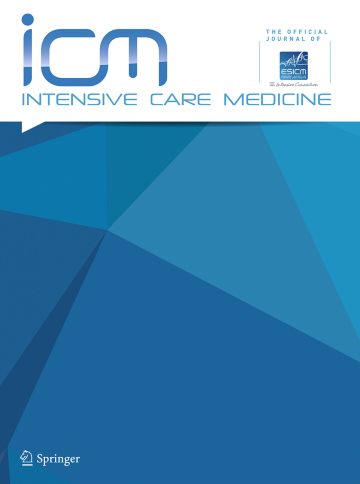护理者途径干预对危重患者家庭护理人员重症监护后综合征症状的影响:一项随机对照试验的长期结果
IF 21.2
1区 医学
Q1 CRITICAL CARE MEDICINE
引用次数: 0
摘要
目的:对家庭照顾者重症监护后症状(PICS-F)随访模型——照顾者路径进行长期评估。方法采用单中心非盲随机对照试验,纳入196例危重患者家属护理人员,随机分为干预组(n = 101)和对照组(n = 95)。护理人员途径干预包括:(1)在ICU的头几天与护士进行数字评估,(2)离开ICU时提供支持卡,(3)在患者转移到降级病房后接受电话通知,以及(4)出院后3个月内进行随访对话。在6个月和12个月收集结果测量,包括创伤后应激障碍(PTSD)症状、焦虑、抑郁、健康相关生活质量(HRQoL)、希望和自我效能感。结果与对照组相比,护理者途径与6个月后PTSD症状的显著影响相关,IES-R平均评分:25.8 [95% CI 21.9-29.7]对30.9 [95% CI 26.7-35.0], p = 0.009, 12个月后的影响趋势:IES-R评分:25.0 [95% CI 21.3-28.7]对28.4 [95% CI 24.1-32.7], p = 0.057。12个月的亚组分析显示,与对照组相比,幸存患者的家庭照顾者对PTSD的干预效果显著,ias - r评分:19.8 [95% CI 15.3-24.2]对29.1 [95% CI 23.5-34.6], p = 0.001,焦虑,HADS-A评分:4.3 [95% CI 3.1-5.4]对6.8 [95% CI 5.2-8.4], p = 0.003。结论照护者途径有可能减轻PICS-F的症状,特别是在患者存活的家庭照护者中。本文章由计算机程序翻译,如有差异,请以英文原文为准。
Effects of The Caregiver Pathway intervention on symptoms of post-intensive care syndrome among family caregivers to critically ill patients: long-term results from a randomized controlled trial.
PURPOSE
A long-term evaluation of The Caregiver Pathway, a model to follow up family caregivers on Post-intensive Care Symptoms among Family (PICS-F).
METHODS
A single-center non-blinded randomized controlled trial including 196 family caregivers to critically ill patients randomized to intervention (n = 101) or control group (n = 95). The Caregiver Pathway intervention consists of: (1) a digital assessment followed by a conversation with a nurse in the first days at the ICU, (2) a supportive card when leaving the ICU, (3) an offer to receive a phone call following patient transfer to a step-down unit, and (4) a follow-up conversation within 3 months after discharge. Outcome measures were collected at 6 and 12 months, including symptoms of post-traumatic stress disorder (PTSD), anxiety, depression, Health-related Quality of Life (HRQoL), hope, and self-efficacy.
RESULTS
The Caregiver Pathway was associated with a significant effect for symptoms of PTSD after 6 months compared with controls, mean IES-R score: 25.8 [95% CI 21.9-29.7] versus 30.9 [95% CI 26.7-35.0], p = 0.009, and a trend toward an effect after 12 months: IES-R score: 25.0 [95% CI 21.3-28.7] versus 28.4 [95% CI 24.1-32.7], p = 0.057. Subgroup analyses at 12 months showed a significant intervention effect among family caregivers of patients who survived compared to controls for PTSD, IES-R score: 19.8 [95% CI 15.3-24.2] versus 29.1 [95% CI 23.5-34.6], p = 0.001, and anxiety, HADS-A score: 4.3 [95% CI 3.1-5.4] versus 6.8 [95% CI 5.2-8.4], p = 0.003.
CONCLUSIONS
The Caregiver Pathway has the potential to reduce the symptoms of PICS-F, especially among family caregivers whose patient has survived.
求助全文
通过发布文献求助,成功后即可免费获取论文全文。
去求助
来源期刊

Intensive Care Medicine
医学-危重病医学
CiteScore
51.50
自引率
2.80%
发文量
326
审稿时长
1 months
期刊介绍:
Intensive Care Medicine is the premier publication platform fostering the communication and exchange of cutting-edge research and ideas within the field of intensive care medicine on a comprehensive scale. Catering to professionals involved in intensive medical care, including intensivists, medical specialists, nurses, and other healthcare professionals, ICM stands as the official journal of The European Society of Intensive Care Medicine. ICM is dedicated to advancing the understanding and practice of intensive care medicine among professionals in Europe and beyond. The journal provides a robust platform for disseminating current research findings and innovative ideas in intensive care medicine. Content published in Intensive Care Medicine encompasses a wide range, including review articles, original research papers, letters, reviews, debates, and more.
 求助内容:
求助内容: 应助结果提醒方式:
应助结果提醒方式:


